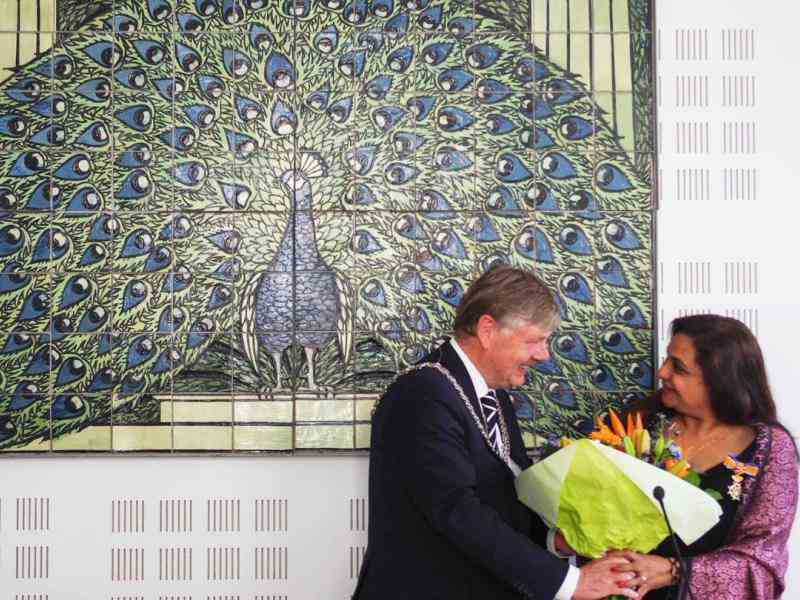Introduction
Jeroo Billimoria launched Childline, the country's first attempt at making street children's quick access to supports, such as police assistance and health care, as easy as dialing a number. Manned by street children themselves, Childline combines 24-hour emergency telephone services with follow-up support to alleviate their distress.
The New Idea
Since pay phones are as ubiquitous as working children in the streets of Indian cities, Jeroo Billimoria is bringing the two together in a program to provide ready communication and support linkages to the country's more than 48 million street children. Jeroo has demonstrated and refined the model in the city of Mumbai (Bombay) and now aims to replicate it nationally.
Childline can be accessed free through a toll-free number, 1098, from Mahanagar Telephone Nigam Limited (MTNL), the monopoly government telecom agency. Childline divides a city into geographical zones. An incoming call is routed to the zone closest to the caller through facilities provided by MTNL. The Childline phones are located in partner service organizations' facilities. Trained volunteer street children take the calls and make the link to relevant services. The volunteer on the line meets the street child and takes the necessary follow-up steps or refers the caller to a support organization enlisted by Childline in the zone.
In two years, Childline has attended to over 10,000 calls and directly provided assistance to over 3,750 children in Mumbai. The national ministry for Social Justice and Empowerment has taken up Childline and will spread its net across the country as a government program.
For Jeroo, Childline does not stop at being an emergency helpline. "Children need systems that are inclusive and driven by them, systems that will enable them to respond to their feelings and needs at any time," she says. Childline is, therefore, sensitizing its collateral agencies – police, hospitals, city municipal corporations, and health care systems – to respond to and develop support interventions for children in difficult situations. These are official systems that themselves often bear violently on the lives of street children in India.
Childline is also documenting its experiences, monitoring its day-to-day management systems, and collating the information into a database on issues related to street children in distress. A crucial engagement of Childline in this area will be to define a best practice map of successful interventions.
Thus Jeroo is bringing together players from across sectors in a service-delivery and advocacy model that benefits all: with telephone in hand, street children can reach out and support each other and create a self-help peerage; nongovernmental organizations have access to a low-cost system that addresses one of the most frustrating aspects of their job – being at the right place at the right time; and the government partners with citizens in a consultative and collaborative process to protect the rights of the child, thus playing out an active role as signatory to the United Nations Convention on the Rights of the Child.
The Problem
The population of street children in India is the highest in the world. The urge for independence, emotional trauma, and economic destitution drive children away from home or take them to the streets to earn a living. Health-related problems such as sickness and injuries are everyday affairs for them, alongside and exacerbated by sexual abuse, drug addiction and violence by police officials.
With no comprehensive government schemes for their rehabilitation and the lack of a strong labor movement, the growing numbers of street children (48 million at last count) have become an embarrassing reality for the country. While support services exist, they fall far short of matching the need. For example, in Bombay alone, the estimated numbers of street children is 130,000, while there are only 40 organizations to serve this client base. The key challenge for them is to provide street children in distress timely supports without being unrealistic about their service capacities.
Prevalent efforts in the field have focused attention on institutional rehabilitation and have been entirely adult-led. This has limited reach and is heavy on cost and infrastructure. Also citizen sector service organizations have not attempted to combine their efforts, preferring to work independently and "reinvent the wheel."
The Strategy
The idea of Childline took root in 1993 when Jeroo, then a professor at the Tata Institute of Social Sciences (TISS), Mumbai, opened negotiations with the Juvenile Act Protection Unit of the police to use the Mumbai police control room for an emergency telephone service for the city's street children. At that time, Childline was an experimental project of TISS, among a series of action-based programs to provide on-the-ground experience in its courses. Police stolidity, however, led Jeroo to switch tactics. In 1993 she approached MTNL for a toll free number, and 1098 came a year later.
Client awareness was the greatest challenge for Childline. Free, easy, 24-hour access to the phone would look like an elitist luxury: "Would Childline serve rich children first?" Such suspicion had to be purged, and then strategies were designed to deter street children from abusing the service. Bringing service organizations in the field into a common platform was another challenge.
Through day contact centers maintained by service organizations, Childline marshaled together volunteers who they trained as volunteers. The volunteers then conducted exhaustive awareness and outreach programs for their peers in natural "hang out" places. They encouraged other children to dial 1098 and test Childline.
Simultaneously, Childline created an exhaustive database of supports and services available in Mumbai for street children and invited them all to participate in Childline's structural conception and the launch of its service in the city.
Childline's architecture matches that collaborative spirit. Partner organizations that work with street children supply the infrastructure in the form of receiving centers where calls to 1098 are directed and where night shelter is available; they also assume responsibility for managing the volunteer staff of street children. Each of the facilities has two dedicated Childline phones and houses seven Childline members. Two of the volunteers attend to calls every seven-hour shift. Standby-staff from the organization man the phones if Childline members have to rush out for case follow-up. In addition to the primary receiving centers, Childline maintains a referral network of support agencies or organizations that provide service to calls directed to them by a Childline partner agency. Their principal role is to undertake long-term follow-up and rehabilitation. Each is allotted a specific geographical area where it conducts outreach and awareness programs. They also provide access to government systems. TISS has had an ongoing support role that includes designing information management, training documentation, advocacy, and liaising with collateral agencies such as the police and the health system.
Sensitization of collateral agencies like the police and the state health care systems were vital and opened doors to crucial partners. For example, in a police training workshop organized by the Childline and the Coordination Committee for Working Children, 505 police personnel participated. The workshop flagged off the Chacha Police ("uncle" Police) program which aims to turn around the demonic stereotype of the police that the street children carry in their minds and give the police officer a humane, friendly face. Sustained workshops with the police have led to growing membership of the Chacha Police Club. And Childline's clientele and members have reported positive interaction and quick support with this new friendly band.
Similarly, systemic awareness drives with health officials later assisted prompt follow-up services to distress callers and will pave the way for concrete health interventions.
Jeroo emphasizes close monitoring and documentation. Through computer databases that street children can use and especially designed call registers, every call received by a Childline volunteer is recorded. Jeroo belongs to a "think tank" which engages constantly with the telephone department to identify and plug technical glitches, conducts regular dialogue with clients (street children and concerned adults), and encourages – for Childline and all its partner organizations – quality-control processes devised for tracking and monitoring the service's effectiveness. To expedite external, objective monitoring, Jeroo plans to place students from academic institutions into Childline centers for fieldwork experience and research analysis.
As Childline spreads nationally, Jeroo is planning to design an online database system. All national partners could then access this database at any time. Within ten years she plans to replicate the model in 158 cities, a task with which she is being assisted by UNICEF and CRY (Child Relief and You). Childline has put together exhaustive, easy-to-use manuals and guidelines based on its experiences in Mumbai to facilitate the process.
In order to match Childline's national growth with greater organizational and staff capacity, Jeroo plans to make the program independent of TISS in 1999. As the phone service replicates, she will set up a Childline national board that will oversee the process.
The Person
Jeroo was born in 1965 in Bombay into a family of chartered accountants. Her mother influenced Jeroo with strong values and prepared her for the profession she was to join later. A professor in the Tata Institute of Social Sciences (TISS), she provided Jeroo tough socialization skills and high standards of professionalism. However, it was her father's death that turned around Jeroo's decision to join the family profession.
"My father was a quiet philanthropic person. When he died young, we had long queues of people from the streets who arrived to pay their respects. Even my mother did not know that he had silently supported them through the years," Jeroo says. She was 18 then. Instead of beginning her training in chartered accountancy, she enrolled in TISS for a post-graduate course in social work.
Her years in college depressed her. "I saw condescension and a lot of heavy attitude everywhere. It had to do with the tendency that people in the development sector have in this country: they talk down to others," she says. She was also appalled by the lack of professionalism in the sector. However, not one to give up, she went to New York for a two-year course on non-profit management in the New School for Social Research. There she joined the Coalition for the Homeless, started by Robert Hayes.
The experience changed Jeroo's life. "It gave me a close view of the problem of the homeless. It threw me into their painful lives. I saw the spirit of survival among them," she says. Back in India, she traveled widely and set up Unnati, a non-profit center for the rehabilitation of street children. However, it did not work because "the climate for networking among NGOs was not there," Jeroo says. Some years later, Childline emerged. Jeroo has also set up Meljol: Hum Bachchon Ka, an organization that is committed to a movement led and directed by children.

 Tile image
Tile image Tile image
Tile image Tile image
Tile image